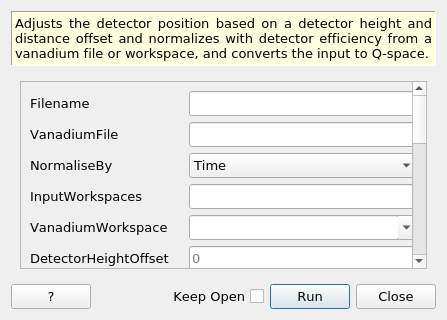\(\renewcommand\AA{\unicode{x212B}}\)
HB3AAdjustSampleNorm v1¶

HB3AAdjustSampleNorm dialog.¶
Summary¶
Adjusts the detector position based on a detector height and distance offset and normalizes with detector efficiency from a vanadium file or workspace, and converts the input to Q-space.
See Also¶
ConvertWANDSCDtoQ, ConvertHFIRSCDtoMDE, HB3AFindPeaks, HB3APredictPeaks, HB3AIntegratePeaks
Properties¶
Name |
Direction |
Type |
Default |
Description |
|---|---|---|---|---|
Filename |
Input |
list of str lists |
Input autoreduced detector scan data files to convert to Q-space. Allowed extensions: [‘.nxs.h5’, ‘.nxs’] |
|
VanadiumFile |
Input |
string |
File with Vanadium normalization scan data. Allowed extensions: [‘.nxs’] |
|
NormaliseBy |
Input |
string |
Time |
Normalise to monitor, time or None. Allowed values: [‘None’, ‘Time’, ‘Monitor’] |
InputWorkspaces |
Input |
string |
Workspace or comma-separated workspace list containing input MDHisto scan data. |
|
VanadiumWorkspace |
Input |
IMDHistoWorkspace |
MDHisto workspace containing vanadium normalization data |
|
DetectorHeightOffset |
Input |
number |
0 |
Optional distance (in meters) to move detector height (relative to current position) |
DetectorDistanceOffset |
Input |
number |
0 |
Optional distance (in meters) to move detector distance (relative to current position) |
Wavelength |
Input |
number |
Optional |
Optional wavelength value to use as backup if one was not found in the sample log |
OutputType |
Input |
string |
Q-sample events |
Whether to use ConvertHFIRSCDtoQ for an MDEvent, or ConvertWANDSCDtoQ for an MDHisto. Allowed values: [‘Q-sample events’, ‘Q-sample histogram’, ‘Detector’] |
ScaleByMotorStep |
Input |
boolean |
False |
If True then the intensity of the output in Q space will be scaled by the motor step size. This will allow directly comparing the intensity of data measure with diffrent motor step sizes. |
MinValues |
Input |
dbl list |
-10,-10,-10 |
3 comma separated values, one for each q_sample dimension |
MaxValues |
Input |
dbl list |
10,10,10 |
3 comma separated values, one for each q_sample dimension; must be larger thanthose specified in MinValues |
MergeInputs |
Input |
boolean |
False |
If all inputs should be merged into one MDEvent output workspace |
BinningDim0 |
Input |
dbl list |
-8.02,8.02,401 |
Binning parameters for the 0th dimension. Enter it as acomma-separated list of values with theformat: ‘minimum,maximum,number_of_bins’. |
BinningDim1 |
Input |
dbl list |
-2.52,2.52,126 |
Binning parameters for the 1st dimension. Enter it as acomma-separated list of values with theformat: ‘minimum,maximum,number_of_bins’. |
BinningDim2 |
Input |
dbl list |
-8.02,8.02,401 |
Binning parameters for the 2nd dimension. Enter it as acomma-separated list of values with theformat: ‘minimum,maximum,number_of_bins’. |
OutputWorkspace |
Output |
Mandatory |
Output MDWorkspace in Q-space, name is prefix if multiple input files were provided. |
Description¶
Takes in DEMAND detector scan data from files or workspaces and converts them to Q-space, providing an optional adjustment of the detector positions. DetectorHeightOffset adjusts all banks along the y-axis, and DetectorDistanceOffset adjusts banks along the z-axis. Both parameters move the detector relative to the current detector position.
The output can be either an MDEventWorkspace or a MDHistoWorkspace. For a MDHistoWorkspace, the conversion to Q-space is done using ConvertWANDSCDtoQ while ConvertHFIRSCDtoMDE is used for outputting an MDEventWorkspace.
If multiple data file are included then the output will be a WorkspaceGroup containing all the MDWorkspaces.
Normalisation¶
During loading a few different types of normalisation can be applied, vanadium, time or monitor and motor step size. VanadiumFile or VanadiumWorkspace is applied by dividing the data detector pixel-by-pixel. The NormaliseBy option time or monitor uses that log values from the data (and vanadium if used) input and is applied to each scan axis step. The ScaleByMotorStep scales the entire data by the step size of either the omega or chi axis, this is only using when converting to Q-sample and allows the comparison of peak intensities found with IntegratePeaksMD to be directly compared between scans measured with different step sizes.
See HB3AIntegratePeaks for complete examples of the HB3A workflow.
Categories: AlgorithmIndex | Crystal\Corrections
Source¶
Python: HB3AAdjustSampleNorm.py
